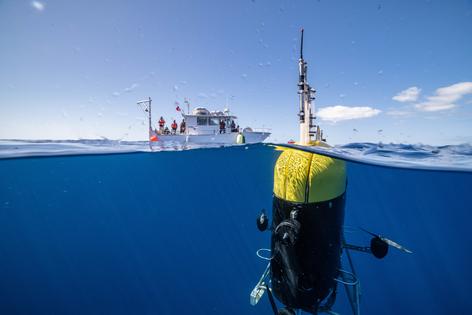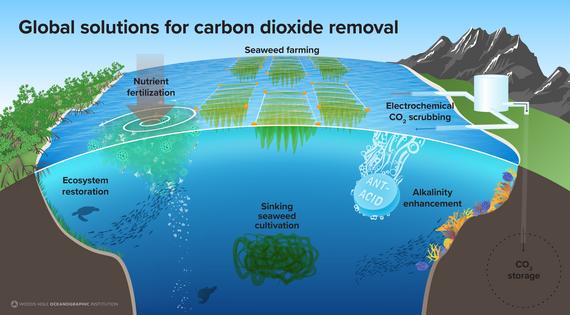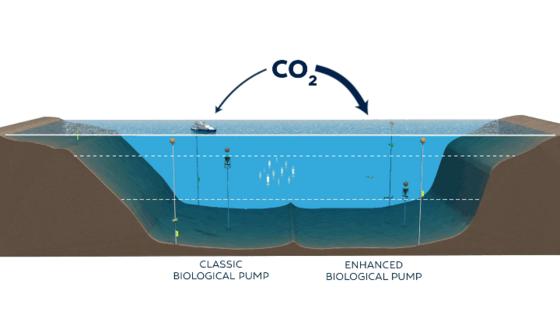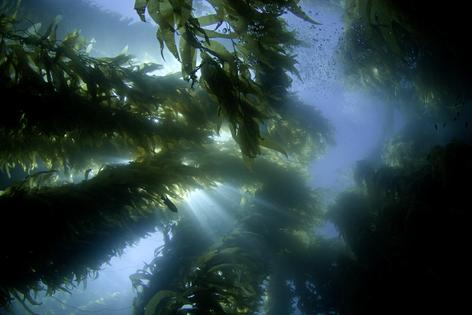The ocean twilight zone could store vast amounts of carbon captured from the atmosphere – but first we need to build a 4D system to track what's going on down there
Published in Science & Technology News
Deep below the ocean surface, the light fades into a twilight zone where whales and fish migrate and dead algae and zooplankton rain down from above. This is the heart of the ocean’s carbon pump, part of the natural ocean processes that capture about a third of all human-produced carbon dioxide and sink it into the deep sea, where it remains for hundreds of years.
There may be ways to enhance these processes so the ocean pulls more carbon out of the atmosphere to help slow climate change. Yet little is known about the consequences.
Peter de Menocal, a marine paleoclimatologist and director of Woods Hole Oceanographic Institution, discussed ocean carbon dioxide removal at a recent TEDxBoston: Planetary Stewardship event. In this interview, he dives deeper into the risks and benefits of human intervention and describes an ambitious plan to build a vast monitoring network of autonomous sensors in the ocean to help humanity understand the impact.
The ocean is like a big carbonated beverage. Although it doesn’t fizz, it has about 50 times more carbon than the atmosphere. So, for taking carbon out of the atmosphere and storing it someplace where it won’t continue to warm the planet, the ocean is the single biggest place it can go.
Ocean carbon dioxide removal, or ocean CDR, uses the ocean’s natural ability to take up carbon on a large scale and amplifies it.
Carbon gets into the ocean from the atmosphere in two ways.
In the first, air dissolves into the ocean surface. Winds and crashing waves mix it into the upper half-mile or so, and because seawater is slightly alkaline, the carbon dioxide is absorbed into the ocean.
The second involves the biologic pump. The ocean is a living medium – it has algae and fish and whales, and when that organic material is eaten or dies, it gets recycled. It rains down through the ocean and makes its way to the ocean twilight zone, a level around 650 to 3300 feet (roughly 200 to 1,000 meters) deep.
The ocean twilight zone sustains biologic activity in the oceans. It is the “soil” of the ocean where organic carbon and nutrients accumulate and are recycled by microbes. It is also home to the largest animal migration on the planet. Each day trillions of fish and other organisms migrate from the depths to the surface to feed on plankton and one another, and go back down, acting like a large carbon pump that captures carbon from the surface and shunts it down into the deep oceans where it is stored away from the atmosphere.
The single most shocking sentence I have read in my career was in the Intergovernmental Panel on Climate Change’s Sixth Assessment Report, released in 2021. It said that we have delayed action on climate change for so long that removing carbon dioxide from the atmosphere is now necessary for all pathways to keep global warming under 1.5 degrees Celsius (2.7 F). Beyond that, climate change’s impacts become increasingly dangerous and unpredictable.
Because of its volume and carbon storage potential, the ocean is really the only arrow in our quiver that has the ability to take up and store carbon at the scale and urgency required.
A 2022 report by the national academies outlined a research strategy for ocean carbon dioxide removal. The three most promising methods all explore ways to enhance the ocean’s natural ability to take up more carbon.
The first is ocean alkalinity enhancement. The oceans are salty – they’re naturally alkaline, with a pH of about 8.1. Increasing alkalinity by dissolving certain powdered rocks and minerals makes the ocean a chemical sponge for atmospheric CO2.
A second method adds micronutrients to the surface ocean, particularly soluble iron. Very small amounts of soluble iron can stimulate greater productivity, or algae growth, which drives a more vigorous biologic pump. Over a dozen of these experiments have been done, so we know it works.
Third is perhaps the easiest to understand – grow kelp in the ocean, which captures carbon at the surface through photosynthesis, then bale it and sink it to the deep ocean.
But all of these methods have drawbacks for large-scale use, including cost and unanticipated consequences.
I’m not advocating for any one of these, or for ocean CDR more generally. But I do believe accelerating research to understand the impacts of these methods is essential. The ocean is essential for everything humans depend on – food, water, shelter, crops, climate stability. It’s the lungs of the planet. So we need to know if these ocean-based technologies to reduce carbon dioxide and climate risk are viable, safe and scalable.
The ocean is changing rapidly, and it is the single biggest cog in Earth’s climate engine, yet we have almost no observations of the subsurface ocean to understand how these changes are affecting the things we care about. We’re basically flying blind at a time when we most need observations. Moreover, if we were to try any of these carbon removal technologies at any scale right now, we wouldn’t be able to measure or verify their effectiveness or assess impacts on ocean health and ecosystems.
So, we are leading an initiative at Woods Hole Oceanographic Institution to build the world’s first internet for the ocean, called the Ocean Vital Signs Network. It’s a large network of moorings and sensors that provides 4D eyes on the oceans – the fourth dimension being time – that are always on, always connected to monitor these carbon cycling processes and ocean health.
Right now, there is about one ocean sensor in the global Argo program for every patch of ocean the size of Texas. These go up and down like pogo sticks, mostly measuring temperature and salinity.
We envision a central hub in the middle of an ocean basin where a dense network of intelligent gliders and autonomous vehicles measure ocean properties including carbon and other vital signs of ocean and planetary health. These vehicles can dock, repower, upload data they’ve collected and go out to collect more. The vehicles would be sharing information and making intelligent sampling decisions as they measure the chemistry, biology and environmental DNA for a volume of the ocean that’s really representative of how the ocean works.
Having that kind of network of autonomous vehicles, able to come back in and power up in the middle of the ocean from wave or solar or wind energy at the mooring site and send data to a satellite, could launch a new era of ocean observing and discovery.
We’re already doing much of this engineering and technology development. What we haven’t done yet is stitch it all together.
For example, we have a team that works with blue light lasers for communicating in the ocean. Underwater, you can’t use electromagnetic radiation as cellphones do, because seawater is conductive. Instead, you have to use sound or light to communicate underwater.
We also have an acoustics communications group that works on swarming technologies and communications between nearby vehicles. Another group works on how to dock vehicles into moorings in the middle of the ocean. Another specializes in mooring design. Another is building chemical sensors and physical sensors that measure ocean properties and environmental DNA.
This summer, 2023, an experiment in the North Atlantic called the Ocean Twilight Zone Project will image the larger functioning of the ocean over a big piece of real estate at the scale at which ocean processes actually work.
We’ll have acoustic transceivers that can create a 4D image over time of these dark, hidden regions, along with gliders, new sensors we call “minions” that will be looking at ocean carbon flow, nutrients and oxygen changes. “Minions” are basically sensors the size of a soda bottle that go down to a fixed depth, say 1,000 meters (0.6 miles), and use essentially an iPhone camera pointing up to take pictures of all the material floating down through the water column. That lets us quantify how much organic carbon is making its way into this old, cold deep water, where it can remain for centuries.
For the first time we’ll be able to see just how patchy productivity is in the ocean, how carbon gets into the ocean and if we can quantify those carbon flows.
That’s a game-changer. The results can help establish the effectiveness and ground rules for using CDR. It’s a Wild West out there – nobody is watching the oceans or paying attention. This network makes observation possible for making decisions that will affect future generations.
Humanity doesn’t have a lot of time to reduce carbon emissions and to lower carbon dioxide concentrations in the atmosphere.
The reason scientists are working so diligently on this is not because we’re big fans of CDR, but because we know the oceans may be able to help. With an ocean internet of sensors, we can really understand how the ocean works including the risks and benefits of ocean CDR.
This article is republished from The Conversation, an independent nonprofit news site dedicated to sharing ideas from academic experts. Like this article? Subscribe to our weekly newsletter.
Read more:
Nations are pledging to create ocean preserves – how do those promises add up?
Geoengineering the ocean to fight climate change raises serious environmental justice questions
Peter de Menocal is the president and director of Woods Hole Oceanographic Institution.

















Comments